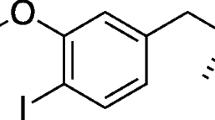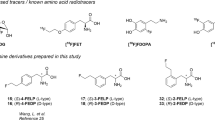Abstract
Purpose
The purpose of this study was to evaluate the usefulness of L-4-borono-2-18F-fluoro-phenylalanine (18F-FBPA) as a tumor-specific probe, in comparison to 18F-FDG and 11C-methionine (Met), focusing on its transport selectivity by L-type amino acid transporter 1 (LAT1), which is highly upregulated in cancers.
Methods
Cellular analyses of FBPA were performed to evaluate the transportablity and Km value. PET studies were performed in rat xenograft models of C6 glioma (n = 12) and in rat models of turpentine oil-induced subcutaneous inflammation (n = 9). The kinetic parameters and uptake values on static PET images were compared using the one-tissue compartment model (K1, k2) and maximum standardized uptake value (SUVmax).
Results
The cellular analyses showed that FBPA had a lower affinity to a normal cell-type transporter LAT2 and induced less efflux through LAT2 among FBPA, Met, and BPA, while the efflux through LAT1 induced by FBPA was similar among the three compounds. The Km value of 18F-FBPA for LAT1 (196.8 ± 11.4 μM) was dramatically lower than that for LAT2 (2813.8 ± 574.5 μM), suggesting the higher selectivity of 18F-FBPA for LAT1. K1 and k2 values were significantly smaller in 18F-FBPA PET (K1 = 0.04 ± 0.01 ml/ccm/min and k2 = 0.07 ± 0.01 /min) as compared to 11C-Met PET (0.22 ± 0.09 and 0.52 ± 0.10, respectively) in inflammatory lesions. Static PET analysis based on the SUVmax showed significantly higher accumulation of 18F-FDG in the tumor and inflammatory lesions (7.2 ± 2.1 and 4.6 ± 0.63, respectively) as compared to both 18F-FBPA (3.2 ± 0.40 and 1.9 ± 0.19) and 11C-Met (3.4 ± 0.43 and 1.6 ± 0.11). No significant difference was observed between 18F-FBPA and 11C-Met in the static PET images.
Conclusion
This study shows the utility of 18F-FBPA as a tumor-specific probe of LAT1 with low accumulation in the inflammatory lesions.








Similar content being viewed by others
References
Imahori Y, Ueda S, Ohmori Y, Kusuki T, Ono K, Fujii R, et al. Fluorine-18-labeled fluoroboronophenylalanine PET in patients with glioma. J Nucl Med. 1998;39(2):325–33.
Pisarev MA, Dagrosa MA, Juvenal GJ. Boron neutron capture therapy in cancer: past, present and future. Arq Bras Endocrinol Metabol. 2007;51(5):852–6.
Wongthai P, Hagiwara K, Miyoshi Y, Wiriyasermkul P, Wei L, Ohgaki R, et al. Boronophenylalanine, a boron delivery agent for boron neutron capture therapy, is transported by ATB0,+, LAT1 and LAT2. Cancer Sci. 2015;106(3):279–86.
Kanai Y, Segawa H, Miyamoto K, Uchino H, Takeda E, Endou H. Expression cloning and characterization of a transporter for large neutral amino acids activated by the heavy chain of 4F2 antigen (CD98). J Biol Chem. 1998;273(37):23629–32.
Shimizu A, Kaira K, Kato M, Yasuda M, Takahashi A, Tominaga H, et al. Prognostic significance of L-type amino acid transporter 1 (LAT1) expression in cutaneous melanoma. Melanoma Res. 2015;25(5):399–405.
Koshi H, Sano T, Handa T, Yanagawa T, Saitou K, Nagamori S, et al. L-type amino acid transporter-1 and CD98 expression in bone and soft tissue tumors. Pathol Int. 2015;65(9):460–7.
Nakada N, Mikami T, Hana K, Ichinoe M, Yanagisawa N, Yoshida T, et al. Unique and selective expression of L-amino acid transporter 1 in human tissue as well as being an aspect of oncofetal protein. Histol Histopathol. 2014;29(2):217–27.
Imai H, Kaira K, Oriuchi N, Shimizu K, Tominaga H, Yanagitani N, et al. Inhibition of L-type amino acid transporter 1 has antitumor activity in non-small cell lung cancer. Anticancer Res. 2010;30(12):4819–28.
Hanaoka K, Watabe T, Naka S, Kanai Y, Ikeda H, Horitsugi G, et al. FBPA PET in boron neutron capture therapy for cancer: prediction of B concentration in the tumor and normal tissue in a rat xenograft model. EJNMMI Res. 2014;4(1):70. doi:10.1186/s13550-014-0070-270.
Li S, Zheng Q, Ma Y, Wang Y, Feng Y, Zhao B, et al. Implications of false negative and false positive diagnosis in lymph node staging of NSCLC by means of 18F-FDG PET/CT. PLoS One. 2013;8(10):e78552. doi:10.1371/journal.pone.0078552PONE-D-13-19765.
Isohashi K, Shimosegawa E, Kato H, Kanai Y, Naka S, Fujino K, et al. Optimization of [11C]methionine PET study: appropriate scan timing and effect of plasma amino acid concentrations on the SUV. EJNMMI Res. 2013;3(1):27. doi:10.1186/2191-219X-3-27.
Khunweeraphong N, Nagamori S, Wiriyasermkul P, Nishinaka Y, Wongthai P, Ohgaki R, et al. Establishment of stable cell lines with high expression of heterodimers of human 4F2hc and human amino acid transporter LAT1 or LAT2 and delineation of their differential interaction with alpha-alkyl moieties. J Pharmacol Sci. 2012;119(4):368–80.
Seo JH, Jeon YH, Lee YJ, Yoon GS, Won DI, Ha JH, et al. Trafficking macrophage migration using reporter gene imaging with human sodium iodide symporter in animal models of inflammation. J Nucl Med. 2010;51(10):1637–43.
Bao Q, Newport D, Chen M, Stout DB, Chatziioannou AF. Performance evaluation of the inveon dedicated PET preclinical tomograph based on the NEMA NU-4 standards. J Nucl Med. 2009;50(3):401–8.
Ohshima Y, Hanaoka H, Tominaga H, Kanai Y, Kaira K, Yamaguchi A, et al. Biological evaluation of 3-[18F]fluoro-alpha-methyl-D-tyrosine (D-[18F]FAMT) as a novel amino acid tracer for positron emission tomography. Ann Nucl Med. 2013;27(4):314–24.
Lanz B, Poitry-Yamate C, Gruetter R. Image-derived input function from the vena cava for 18F-FDG PET studies in rats and mice. J Nucl Med. 2014;55(8):1380–8.
Yoshimoto M, Kurihara H, Honda N, Kawai K, Ohe K, Fujii H, et al. Predominant contribution of L-type amino acid transporter to 4-borono-2-18F-fluoro-phenylalanine uptake in human glioblastoma cells. Nucl Med Biol. 2013;40(5):625–9.
Kim DK, Kim IJ, Hwang S, Kook JH, Lee MC, Shin BA, et al. System L-amino acid transporters are differently expressed in rat astrocyte and C6 glioma cells. Neurosci Res. 2004;50(4):437–46.
Yamada S, Kubota K, Kubota R, Ido T, Tamahashi N. High accumulation of fluorine-18-fluorodeoxyglucose in turpentine-induced inflammatory tissue. J Nucl Med. 1995;36(7):1301–6.
Lee SJ, Thien Quach CH, Jung KH, Paik JY, Lee JH, Park JW, et al. Oxidized low-density lipoprotein stimulates macrophage 18F-FDG uptake via hypoxia-inducible factor-1alpha activation through Nox2-dependent reactive oxygen species generation. J Nucl Med. 2014;55(10):1699–705.
Takeshita N, Tohma T, Miyauchi H, Suzuki K, Nishimori T, Ohira G, et al. Suture Granuloma With False-Positive Findings on FDG-PET/CT Resected via Laparoscopic Surgery. Int Surg. 2015;100(4):604–7.
Zhao S, Kuge Y, Yi M, Zhao Y, Hatano T, Magota K, et al. Dynamic 11C-methionine PET analysis has an additional value for differentiating malignant tumors from granulomas: an experimental study using small animal PET. Eur J Nucl Med Mol Imaging. 2011;38(10):1876–86.
Arita H, Kinoshita M, Kagawa N, Fujimoto Y, Kishima H, Hashimoto N, et al. 11C-methionine uptake and intraoperative 5-aminolevulinic acid-induced fluorescence as separate index markers of cell density in glioma: a stereotactic image-histological analysis. Cancer. 2012;118(6):1619–27.
Kinoshita M, Arita H, Goto T, Okita Y, Isohashi K, Watabe T, et al. A novel PET index, 18F-FDG-11C-methionine uptake decoupling score, reflects glioma cell infiltration. J Nucl Med. 2012;53(11):1701–8.
Tsuyuguchi N, Sunada I, Iwai Y, Yamanaka K, Tanaka K, Takami T, et al. Methionine positron emission tomography of recurrent metastatic brain tumor and radiation necrosis after stereotactic radiosurgery: is a differential diagnosis possible? J Neurosurg. 2003;98(5):1056–64.
Yamada Y, Uchida Y, Tatsumi K, Yamaguchi T, Kimura H, Kitahara H, et al. Fluorine-18-fluorodeoxyglucose and carbon-11-methionine evaluation of lymphadenopathy in sarcoidosis. J Nucl Med. 1998;39(7):1160–6.
Tsuyuguchi N, Sunada I, Ohata K, Takami T, Nishio A, Hara M, et al. Evaluation of treatment effects in brain abscess with positron emission tomography: comparison of fluorine-18-fluorodeoxyglucose and carbon-11-methionine. Ann Nucl Med. 2003;17(1):47–51.
Wiriyasermkul P, Nagamori S, Tominaga H, Oriuchi N, Kaira K, Nakao H, et al. Transport of 3-fluoro-L-alpha-methyl-tyrosine by tumor-upregulated L-type amino acid transporter 1: a cause of the tumor uptake in PET. J Nucl Med. 2012;53(8):1253–61.
Wei L, Tominaga H, Ohgaki R, Wiriyasermkul P, Hagiwara K, Okuda S, et al. Specific transport of 3-fluoro-l-alpha-methyl-tyrosine by LAT1 explains its specificity to malignant tumors in imaging. Cancer Sci. 2016;107(3):347–52.
Nariai T, Ishiwata K, Kimura Y, Inaji M, Momose T, Yamamoto T, et al. PET pharmacokinetic analysis to estimate boron concentration in tumor and brain as a guide to plan BNCT for malignant cerebral glioma. Appl Radiat Isot. 2009;67(7-8 Suppl):S348–50.
Popperl G, Kreth FW, Mehrkens JH, Herms J, Seelos K, Koch W, et al. FET PET for the evaluation of untreated gliomas: correlation of FET uptake and uptake kinetics with tumour grading. Eur J Nucl Med Mol Imaging. 2007;34(12):1933–42.
Iwano S, Ito S, Tsuchiya K, Kato K, Naganawa S. What causes false-negative PET findings for solid-type lung cancer? Lung Cancer. 2013;79(2):132–6.
Acknowledgments
We would like to thank all members of the PET Drug Synthesis Department in Osaka University Hospital for the preparation of tracers, Mitsunori Kirihata for providing non-radiolabeled FBPA, Genki Horitsugi, Keiko Matsunaga, Kayako Isohashi, Hiroki Kato, and Mitsuaki Tatsumi for their assistance, other members of department of Bio-system Pharmacology and department of Nuclear Medicine for supporting the experiments in PET Molecular Imaging Center, and Hiroaki Tanigawa, Rumi Saika, and Miyuki Kuroi for excellent technical assistance.
Author information
Authors and Affiliations
Corresponding author
Ethics declarations
Funding
This study was funded by KAKENHI Grant-in-Aid for Scientific Research (S) (Number 24229008) and (A) (Number 24249077) from the Ministry of Education, Culture, Sports, Science and Technology (MEXT), Japan.
Conflict of interest
No other potential conflict of interest relevant to this article was reported.
Ethical approval
All the animal experiments were performed in compliance with the guidelines of the Institute of Experimental Animal Sciences. The protocol was approved by the Animal Care and Use Committee of the Osaka University Graduate School of Medicine (Approval number: 20-144-008).
Electronic supplementary material
Below is the link to the electronic supplementary material.
Supplemental Fig. 1
Scheme of one tissue compartment model for kinetic PET analysis. Kinetic rate constant of K1 is tracer flux from the blood to the tissue, and k2 is flux from tissue to blood. Tracer concentration of the blood (Cb) was estimated by image derived input function, and concentration of the tissue (Ct) was derived from VOI values of the tumor or the inflammatory lesion on PET. (PDF 267 kb)
Rights and permissions
About this article
Cite this article
Watabe, T., Ikeda, H., Nagamori, S. et al. 18F-FBPA as a tumor-specific probe of L-type amino acid transporter 1 (LAT1): a comparison study with 18F-FDG and 11C-Methionine PET. Eur J Nucl Med Mol Imaging 44, 321–331 (2017). https://doi.org/10.1007/s00259-016-3487-1
Received:
Accepted:
Published:
Issue Date:
DOI: https://doi.org/10.1007/s00259-016-3487-1




